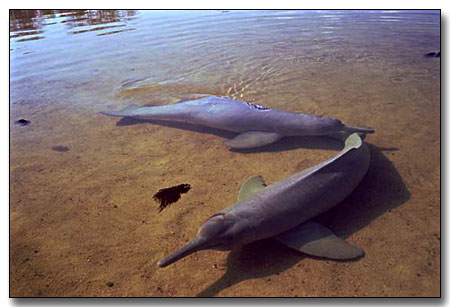The Amazon River dolphin or Inia geoffrensisis is known locally in Brazil as boto or botovermelho. Vera da Silva, author of the Encyclopedia of Marine Mammals’ article, seems to prefer this name. Throughout the article the dolphin is referred to as “the boto.” Good nicknames for the boto could be Pepto Bismo or the Mary Kay crusader because this dolphin is pink. Well not all pink, there is a bit of a progression involved.
The boto’s coloring varies with age. Young dolphins are a dark gray, which becomes lighters as they get older. As adults, more pink enters the picture. According to da Silva, “Adult botos become pinker as a consequence of severe scarring on the body surface. Males are pinker than females and more heavily scarred due to intermale aggression.”
Some photos of the boto show more gray on top with pink underneath, but there are photos where the animal looks all pink, it’s pretty intense. Males are up to 55% heavier than females bringing sexual dimorphism into the picture again. The largest recorded male was more than eight feet long and weighed more than 450 pounds.
Botos are really unique looking animals, they look like a strange cross between a bottlenose dolphin and a beluga whale. They have really long beaks, but larger melon heads like the beluga. Another characteristic botos share with belugas is the ability to move their head in all directions. Very cool. Plus, their flippers have the ability to move in circles and are very large. Da Silva explains in the article that, “Although most of these characteristics restrict speed during swimming, they allow this dolphin to swim backward and to maneuver between trees and submerged vegetation to search for food in the flooded forest.” The perfect adaptation for living in the Amazon river.
There is a little blurb in the article that states, “Several observers have reported seeing botos in a stationary position, often upside down, with their eyes closed.” Ok to me this means the dead position, but maybe the botos are resting and going with the flow along the current. Da Silva doesn’t seemed alarmed, so I am doing my best to follow her lead.
The boto makes the entire Amazon river its home and has been found throughout. Unfortunately, they are facing threats related to fishing practices, damns along the river and habitat destruction. Right now the boto is classified as vulnerable, but unless threats are eliminated this fabulous pink dolphin is on the endangered path. Let’s make sure pink dolphins live to see another day, ensuring a bright friendly face in the midst of the jungle.

[…] (Photo Credit: River Dophins @ OceanWildThings.com) […]